What Do I Need To Start Aquascaping?
So, you have decided what aquascaping style you want to start with. We can discuss everything you need to get together to take the plunge and get things going with your newly planted tank.
Aquascaping is a gratifying hobby, but unfortunately, it can take up to three months to fully establish your new tank. So, being patient and keeping up with the maintenance is very important.

The Tank
There are pros and cons for each size of tank. I recommend a smaller 45CM (17/18 inches) tank for any beginner. You should also choose a space in your home that would be suitable, and selecting a space will also help you choose a size that would fit your space.
When choosing a spot in your home, you need to ensure that the tank won’t get direct sunlight, as this will promote the growth of algae, which is not what we want. So, choose an area where you can enjoy the aquarium away from a window.
You also have the option of a rimless or covered tank. Rimless tanks are the ones that don’t have any visible bracing down the sides and top, which makes them an excellent choice for aquascaping as they add to the tank’s viewing. Rimless also doesn’t have a cover for the top, so you can choose the filter and lighting that would suit your needs.
The only thing I need to mention about the open top that I have experienced is the water evaporation issue. I must add water every second day in the hotter summer months to maintain the water level.
If you are looking at covered tanks, most of them come with a lid that includes a light and filter, which limits what you get versus what you need. You also get lid options that are just the lids, but what I found with having a lid on all the time was that the water temperature went up, which isn’t always what you want.
You also won’t be able to view your tank from the top, which is something I like to do. I think getting a rimless tank that looks prettier and has an open top can have more plants sticking out on the top if you want to.
Small Tank
The smaller tanks are great for beginners to this hobby as your costs are lower (setup and accessories), maintenance and setup of the tank take less time, and it would take up less space in your home.
Unfortunately, with a smaller tank, there are some downsides, too, such as limiting the number of fish you can have. Smaller tanks also have the issue of less water to buffer negative shifts in the water chemistry, especially if you consider the water volume used for the substrate, rocks, and driftwood.
Smaller tanks and the fact that you will have fewer fish in them will also require more nutrients as the fish waste will most likely not be sufficient. Overfeeding your fish also needs to be considered when you have a smaller tank with only a few fish.
With all the negatives I have listed here, this isn’t a great option (ha-ha). Still, keeping your costs lower, in the beginning, will allow you to explore aquascaping, and if this is something you would want to invest more time and money into before being stuck with expensive equipment that you need to try to get rid of,
Medium Tank
A medium-sized tank would be around 60CM (24 inches) and is also a great starter size. This tank size would allow you to combat all the negatives of the smaller tank size. If you can invest more, I highly recommend this size tank.
The size allows you to include more fish, and you have more space to practice your layout to create more depth. The water chemistry will also be more buffered against negative shifts, seeing that the tank’s volume is greater than that of the smaller tank.
Large Tank
The larger-sized tank entails more time spent doing maintenance like pruning, cleaning, and water changes. Unfortunately, the larger tank requires more space and more extensive, expensive accessories in your home.
The initial setup will also be expensive as more substrate and plants would be required. Should you need a heater, the other thing to remember is that your setup will also cost you more electricity bills.
The upside to a larger tank is having more space to include more plants and fish. Depending on what fish and plants you are looking at starting with, you can decide your commitment based on the size tank that you get.
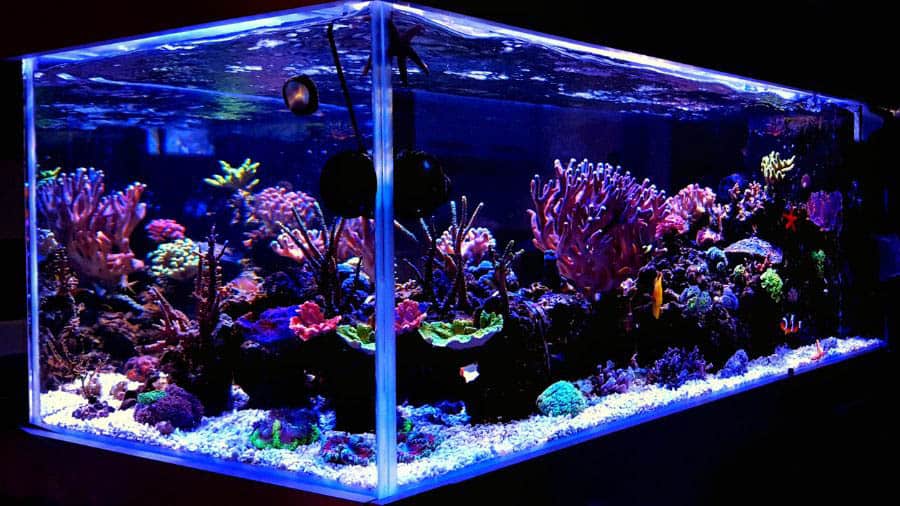
Lighting
When looking at lighting, you have various options available to you. The most popular and value for money would be LED lights, as the lifespan and power usage are both excellent. I will also discuss other lighting options to give more background on your options.
The rough rule of thumb for light requirements is 2 to 4 Watts of lighting per gallon (3.8L) of volume. Remembering that certain plants need certain color temperatures for optimal growth would be best. Usually, the plant requirements range between 5000 and 7000K for most commonly used aquarium plants.
It is tough to understand color temperatures, but here is a rough guide to better understand. A typical household light bulb is about 2700 to 3000K; anything below 6500K is seen as a warmer light color temperature.
Natural sunlight has an even, gentle look and is around 6500K. Colder light temperatures are anything from 7000K and up; a great example of a more complex light is the new car headlights (Xenon).
LED
LED lights come in two options: the dimmable standard white light and RGB, where you can usually customize the colors with a remote or an app on your phone. When you can customize your color hues, you can enhance your fish’s color and set it for optimal plant health, which is a win-win situation for all parties involved.
The other great thing about choosing an LED light is that it doesn’t give off heat, so it won’t affect water temperature. The cool thing about the RGB lights and the settings is that you can set them so they don’t promote algae growth as other lights would.
Fluorescent Light Bulbs
I believe fluorescent lights are the middle ground between LED lights and the other options. These lights are easy to replace and provide even lighting across your tank. Fluorescent lights tend to change their hues as they age.
You will quickly notice when this light needs replacement, as your algae growth will most likely increase once the light isn’t as optimal as it once was.
Metal Halogen Light Bulbs
These lights are commonly used for saltwater tanks but can still be used for freshwater aquariums. I would not recommend this light to anyone as it also tends to become hot, affecting the water temperature in your tank.
The other downside to this option is that it will be more expensive to run than LED or fluorescent lights. What I like about this type of light is the light effect you get within your aquarium.
This light creates the look of shallow water, like a river bank, when the light hits it, which is beautiful, but I don’t know if the additional heat is worth it.
Incandescent Light Bulbs
These lights are a no-go zone for your aquarium, which is scary as some cheaper starter tanks have these types of lights in their hoods. Due to how hot this light can get, one small splash of water means shattered glass in your tank, which doesn’t sound great.
The other downside to this type of light is the fact that the temperature of this light is too warm, which will only result in algae growth and not provide sufficient light to your tank.
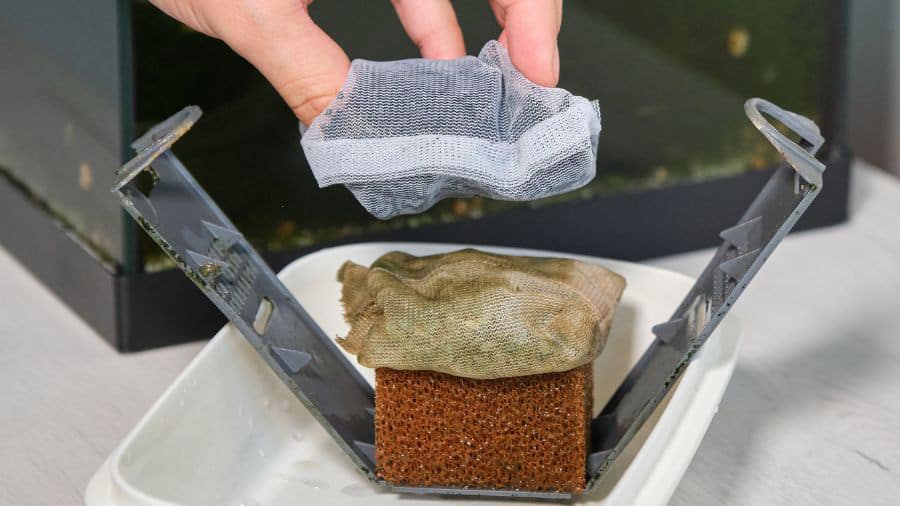
Filter
When looking at filters for your tank, the best rule of thumb would be to look for a filter with a rate of flow that is four times the volume of your aquarium. To give you an example, if you have a 40-gallon tank, you would require a filter that can turn your tank four times in an hour (160gph)
You will have to decide which filter suits your needs the best and which will fit your budget, or maybe you could repurpose it for another tank setup later. I would suggest one that isn’t visible and occupies your tank.
Internal Filter
Internal filters are cheap and easy to clean, and you won’t have to worry about leaks. That is where the pros of this filter option end. Unfortunately, this filter takes up space within your tank and is visible, which doesn’t help your tank’s aesthetic.
This type of filter is the simplest and is more significant for anyone, starting with keeping fish. I am unsure if you would consider this filter for your aquascaping aquarium.
External Filter
This type of filter won’t be seen within your tank and will also not take up space within your tank, but because it is the more bulky option, it needs additional space in your home. You will require a stand or cupboard to hide the filter.
I suppose you have additional storage space to keep all your aquarium things together by having a stand or a cupboard? The other pro of this filter option is that it needs less frequent cleaning than the other filters.
We, unfortunately, have to discuss the cons too, because it is bigger, it is naturally a more expensive option, and you have a chance of it leaking. Leaking is highly unlikely, but there is always a chance.
Hang On The Back Filter
This filter is a very affordable option, which is where the pros end. Unfortunately, this type of filter doesn’t provide you with much space for filter media, and placement of the filter is critical.
The placement needs to be considered as you aren’t able to change the flow of your water, so make sure you are happy with that before choosing this option.

Substrate
When choosing a substrate for your planted aquarium, I recommend Aqua Soil or something similar (coarse). The “balls” allow water to flow, which is excellent for plants wanting to root and flourish in your tank.
If you want to incorporate sand into your tank, I suggest doing so in areas where you aren’t planning on planting anything.
Hardscapes (Rocks/Driftwood)
Hardscapes are totally optional and entirely up to you. Buying decorations such as rocks and driftwood from your local pet shops is sometimes crazy expensive, and we tend to include things that we maybe shouldn’t have in our tank.
Different minerals and tannins could leak into your water, causing havoc to your plants and fish. It is best not to add any old rock or driftwood we found and test or research before adding it to our aquarium.
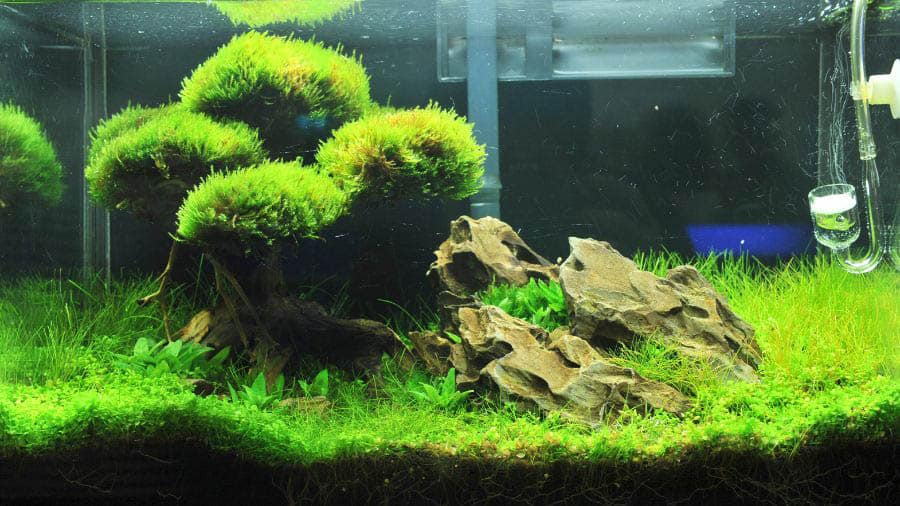
Rocks
Due to the minerals in certain rocks, if you add the wrong type of rock, these minerals can leak into your water, causing your water to become rigid. Famous rocks/stones to include are usually Seiryu, Ryuoh, Millenium, or Geo.
If you are out on a walk and see a rock or stone you like and would like to include in your aquarium, you can test it with vinegar. Ensure the rock is clean and dry, then add some vinegar. You know this is a no-go rock/stone if you see a reaction.
The other easy way to check a rock is if you see it has “veins,” you can also be sure that it has a lot of minerals trapped inside those veins. The veins are a vein-like pattern on or in the rock.
Driftwood
I feel the need to include this part, driftwood is wood that has been in the water for a while and has been worn down to the tricky bit of “skeleton”. Please don’t add wood you find at your neighbor’s house that he cut off his tree a few weeks ago.
Driftwood can release tannins in your water, cause discoloration, and change the PH levels of your tank. So be aware that it can have this effect, and do regular tests to ensure the parameters of your tank water remain at the levels you require.
Common types of driftwood to include in an aquarium are Spiderwood and Redmoor Wood. The safest option for driftwood is to buy it from your local pet shop or online at a reputable place.
Plants
Choosing the right plants to go into your tank is one of the most challenging choices you have to make while planning for your aquascaping. I suggest you search this website for suitable plants compatible with your fish of choice.
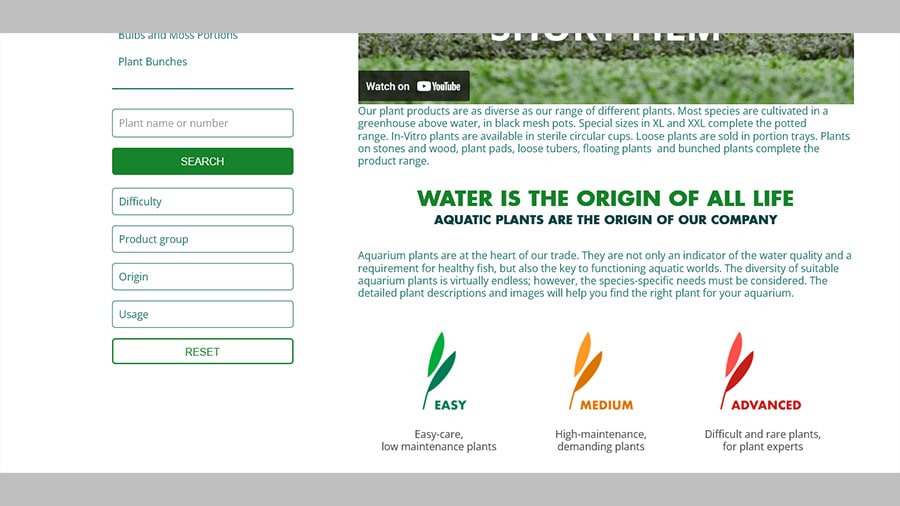
When you search on a website called Dennerle Plants, change the difficulty to easy so you can see options for plants that are easy to care for. The experimenting and change in difficulty can constantly be amended as you gain more experience in the hobby.
If you want to practice placing and setup options with your plants of choice, you can do so. It helps me a lot when I can visualize something, and that helps me make better choices when combining plants and textures when I can see it.
An excellent way to prevent algae in a starter tank is to choose to increase plants. The fast-growing plants will soak up all the nutrients and not leave much for algae to flourish. Once your tank is established, you can permanently remove some faster-growing plants.
Fish
Once your plants have been established, you can add your fish of choice. Unfortunately, installing your tank might take a while (up to 3 months). It is best to add fish food to your tank when you first do the setup to help the ammonia levels of your new tank. The food you add should be the amount you would have added for the number of fish you plan.
You can add food once a week in the beginning, and then, closer to getting your fish, you can test your ammonia levels and then amend what you do based on the levels in your tank. I will discuss this in more detail in the following article.

Fertilizers
When considering what fertilizers are best for beginners, it’s sometimes easier to get the liquid all-in-one option to dose your tank when required. I would also suggest you get some nutrition capsules to add to your substrate before starting to plant.
This will ensure a slow release of nutrients to your plants as they require it. When adding the nutrient capsules, it is essential to remember that you will not need any additional liquid nutrients for the first three to four weeks.
Timers
Timers are not necessary but merely convenient. You can have your lights running on a timer to ensure you stick to a routine of six to eight hours daily. You can plan your timer so that the lights can be on when you are at home.
It is best to start a new tank for six hours a day, depending on your light strength. The stronger your lights are, the less time you should have them on in the beginning to ensure you don’t encourage the algae more.
Should you choose to include CO2 in your tank, the other timer you might require would be a CO2 injector timer. The best time to inject CO2 into your tank would be before the lights come on.
Additional Tools
Here are some additional tools and items you might need to ensure you have before starting. When doing your weekly water changes, you will need a bucket and a hose to remove the water from your tank.
An algae scraper, a toothbrush, and a kitchen sponge are great options for cleaning the glass and entering all the places. Please ensure you use a new toothbrush and sponge for this exercise and only use them for your fish tank.
Tweezers and scissors for aquascaping are a must-have. The tweezers help you place your new plants into the substrate, and you will need the scissors for when you need to start pruning your plants to your liking.
When doing water changes, a thermometer is a must. You need to ensure the new water you add to your tank is roughly the same temperature as the tank water to avoid significant temperature shifts that can cause problems.
Last but not least is a little trusty fish net. Not only will you use your fishnet to move fish when necessary, but you will also require your net to scoop up all the trimmings of the plants after your pruning session.
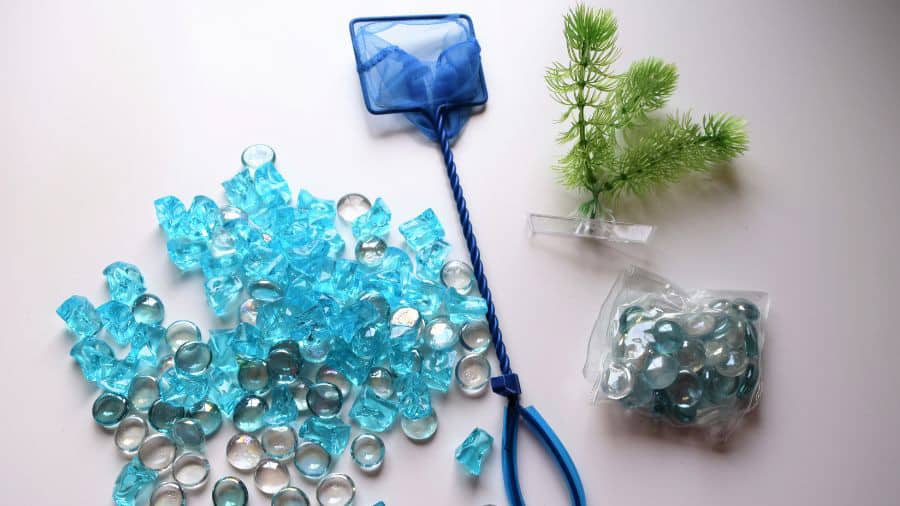
Optional Extras
As mentioned, depending on your chosen filter, you might require a cabinet under your aquarium. This could come in handy for storage, but depending on the available space, this might not be something you can consider.
Once you know that aquascaping is something you will be doing for a long time, investing in a proper water testing kit might be a good idea. I don’t always trust the cheaper strip test, and I think you will benefit from the right way to check your water parameters.
If you want to include a Betta fish, you will require a heater in your setup. Depending on the fish you choose, your requirements will be different. Just make sure the requirements of your fish are compatible with the requirements of the plants you choose.
If you run a tank that requires brighter lights and want your plants to flourish, you will need a CO2 kit for your aquarium. An aquarium with low to moderate lights will not require a CO2 kit, but you can consider this option regardless of your lighting.
I don’t know if you have ever noticed an oil-like or scum layer on the top of your water? If you wish to eliminate it, purchase a surface cleaner/skimmer for your aquarium.
Conclusion
I am sure you have realized that with everything listed above, there are quite a few things to consider. Take your time and review each item, keeping your fish and plants of choice in mind, and choose what is best for their requirements and needs.
Choose a tank size that works for the space and time available for aquascaping. It needs to be something you can enjoy for years to come. So don’t go all in with the most significant size, to spend all your free time trying to maintain everything. Keep it manageable to what you can handle.
I am very excited to hear about your experiences, and I will add more information on the following steps to take in a new article. I will also start a tank from scratch to document all my problems and solutions for you.
